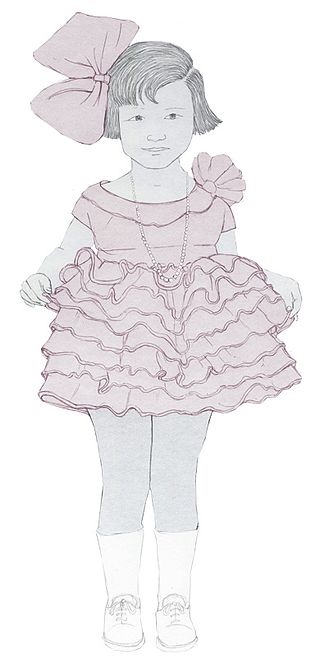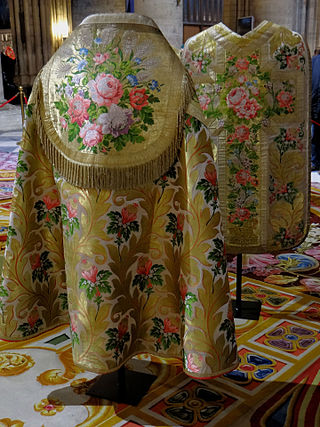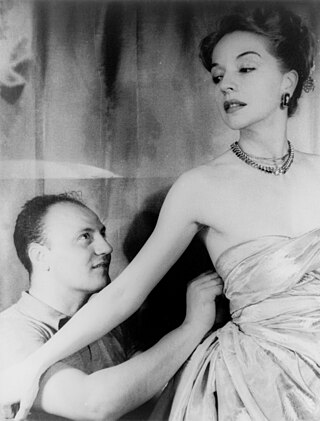Related Research Articles

Poplin, also called tabinet, is a fine wool, cotton or silk fabric that has a vertical warp and a horizontal weft. Nowadays, the name refers to a strong material in a plain weave of any fiber or blend, with crosswise ribs that typically give a corded surface.

Moleskin is a heavy cotton fabric, woven and then shorn to create a short, soft pile on one side. The feel and appearance of its nap is suede-like, less plush than velour and more like felt or chamois. The word is also used for clothing made from this fabric. Clothing made from moleskin is noted for its softness and durability. Some variants of the cloth are so densely woven as to be windproof.

Twill tape or twilled tape is a flat herringbone twill-woven fabric tape or ribbon of cotton, linen, polyester, or wool. It may be used in sewing and tailoring to reinforce seams, make casings, bind edges, and make sturdy ties for closing garments. Twill tape is also used in theatre to tie curtains, cable and scenery to various objects, or to tie cable coils so that they do not unroll.

Crêpe, also spelled crepe or crape, is a silk, wool, or synthetic fiber fabric with a distinctively crisp and crimped appearance. The term "crape" typically refers to a form of the fabric associated specifically with mourning. Crêpe was also historically called "crespe" or "crisp".

Sateen is a fabric made using a satin weave structure but with spun yarn instead of filament yarn. It is a cotton or other non-silk fabric that has the characteristics of silk satin but is less expensive.

Ninon is a lightweight, sheer fabric made with plain or leno weaving, it is a suitable material for curtains, evening wear and lingerie. Ninon is made with variety of filament yarns such as polyester, silk, rayon or nylon.
Sendal, cendal or sandal is a thin and light silk material, chiefly used to make ceremonial clothing, church vestments, and banners. The word derives from Greek σινδων (sindōn), "fine linen"; the old French word is cendal. The word often describes a fabric woven of a linen warp and a silk weft.
Zephyr or zephyr cloth is a sheer, lightweight cotton fabric, usually plain woven, used for dresses, blouses, and shirts. It may be striped or checked. It is named after Zephyr, the Greek god of the west wind.

Broadcloth is a dense, plain woven cloth, historically made of wool. The defining characteristic of broadcloth is not its finished width but the fact that it was woven much wider and then heavily milled in order to shrink it to the required width. The effect of the milling process is to draw the yarns much closer together than could be achieved in the loom and allow the individual fibres of the wool to bind together in a felting process, which results in a dense, blind face cloth with a stiff drape which is highly weather-resistant, hard wearing and capable of taking a cut edge without the need for being hemmed.

Organdy, also spelled Organdie, is a kind of sheer fabric. It is a lightweight balanced plain weave cotton with features of sheerness and crispness.

Brocade is a class of richly decorative shuttle-woven fabrics, often made in coloured silks and sometimes with gold and silver threads. The name, related to the same root as the word "broccoli", comes from Italian broccato meaning "embossed cloth", originally past participle of the verb broccare "to stud, set with nails", from brocco, "small nail", from Latin broccus, "projecting, pointed".

A charvet fabric is woven of silk or acetate in warp-faced rib weave, of a reversed reps type with a double ridge effect. The fabric's name derives from its frequent and "clever" use in the 19th century by the Parisian shirtmaker Charvet. It is characterized by a soft handle and shiny appearance. It also drapes well. The bindings create a herringbone effect parallel to the warp, which make this weave suitable for creating faint diagonal stripe effects for ties, for which the fabric is cut on the bias. Patterns on this base are often made with supplementary weft. The fabric has also been used for mufflers, scarves and robes.

Haute couture is the creation of exclusive custom-fitted high-end fashion design. The term haute couture is French, "haute" meaning "high" or "elegant," and "couture" translating to "sewing" or "dressmaking." The term haute couture generally refers to a specific type of upper garment common in Europe during the 16th to the 18th century, or to the upper portion of a modern dress to distinguish it from the skirt and sleeves. Beginning in the mid-nineteenth century, Paris became the centre of a growing industry that focused on making outfits from high-quality, expensive, often unusual fabric and sewn with extreme attention to detail and finished by the most experienced and capable of sewers—often using time-consuming, hand-executed techniques. Couture translates literally from French as "dressmaking", sewing, or needlework and is also used as a common abbreviation of haute couture and can often refer to the same thing in spirit.

A bolt is a piece of cloth woven on a loom or created by a knitting machine, as it is processed, stored and/or marketed. Consequently, its dimensions are highly variable – flexible and dependent upon the manufacturing, machinery, quantity, size, thickness and quality of the product. It is a unit used in manufacturing, transport and inventory. It is also used as a descriptor for wallpaper, which uses different fabrication machinery. Being encompassing, it is by its nature a generic and ambiguous term of convenience and context, used to describe fabric and wallpaper.

Byzantine silk is silk woven in the Byzantine Empire (Byzantium) from about the fourth century until the Fall of Constantinople in 1453.
Cuttanee was a fine heavy and stout silk and cotton satin of East India, formerly produced for export, with bright coloured woven stripes and sometimes floral designs, used for quilts and upholstery. It was a product of Gujarat in the 17th and 18th centuries.
Eolienne is a lightweight fabric with a ribbed (corded) surface. Generally made by combining silk and cotton or silk and worsted warp and weft, it is similar to poplin but of an even lighter weight.

Sussi or susi is a term for multicolored striped or checked cloth produced mainly in Sindh. Sussi is thin handloom fabric made of cotton, silk, or a blend of the two, with colored warp stripes. Sindh region was known for its production and exports during the Mughal period. Sussi was most often made with red and blue, blue and white, or green and white stripes, but other patterns were also produced. The fabric was exported to England, where sousaes were in great demand in the 18th century.
Agra gauze was a thin, translucent fabric with a loose open weave. The material was made of silk with a plain weave. Agra gauze was also known as Agre. The fabric is named after the Agra city. The cloth was used in trimmings.
Faille is a type of cloth with flat ribs, often made in silk. It has a softer texture than grosgrain, with heavier and wider cords or ribs. Weft yarns are heavier than warp, and it is manufactured in plain weaving. It was especially popular in the 19th century.
References
- Schoeser, Mary (2007). Silk . Yale University Press. ISBN 978-0-300-11741-7.
- Tortora, Phyllis; Merkel, Robert S. (1996). Fairchild's Dictionary of Textiles (7 ed.). Fairchild. ISBN 0-87005-707-3.